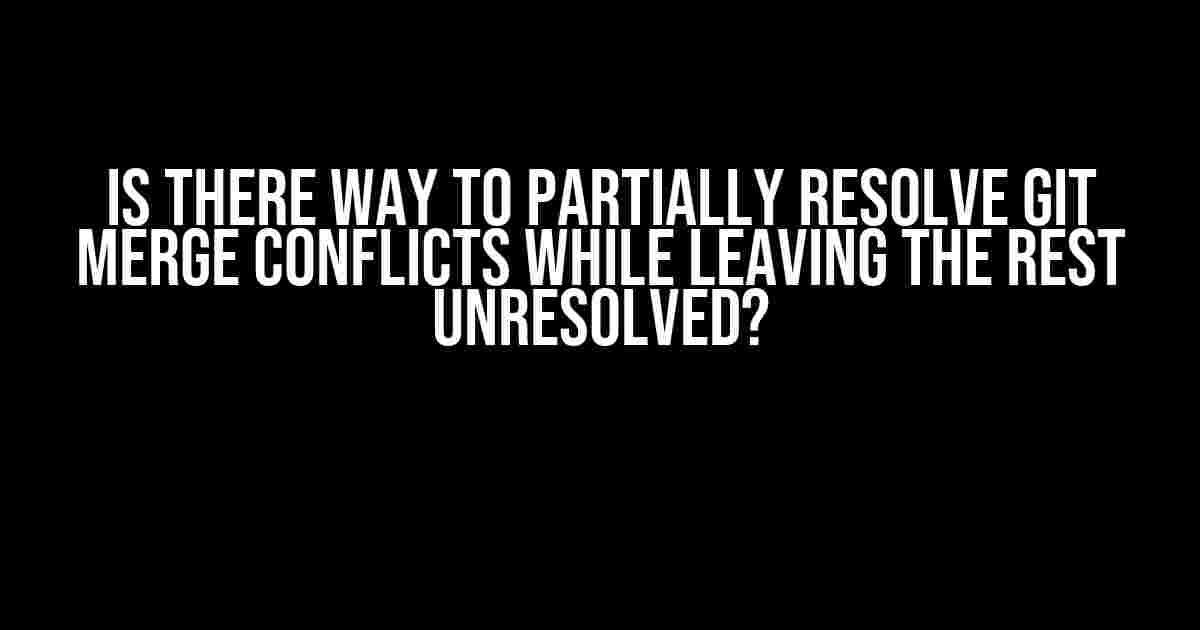Oh, the agony of merge conflicts! It’s like trying to untangle a knot in your favorite sweater. You’ve worked so hard on those changes, and now Git is yelling at you to resolve the conflicts before you can even think about pushing them to the world. But what if you could tame the beast, just a little? What if you could partially resolve those conflicts, leaving the rest for later? Well, buckle up, friend, because today we’re going to explore the mystical realm of git merge --no-commit and git add -p.
The Problem: Merge Conflicts Galore
Let’s set the scene: you’ve been working on a feature branch, and it’s time to merge it into your main branch (aka master). You run the usual git merge --no-ff feature/branch, expecting a smooth merge. But, alas, Git has other plans.Conflict markers litter your code like a pixelated raincloud. It’s like the merge gods have declared war on your sanity.
<<<<<<< HEAD
// conflicting code
||||||| merged common ancestors
// more conflicting code
=======
// yet more conflicting code
>>>>>>> feature/branch
Your heart sinks. You didn’t sign up for this level of drama. But fear not, young coder! We’re about to tame this beast and restore order to your codebase.
The Solution: Partial Conflict Resolution
The secret to partially resolving merge conflicts lies in two Git commands:
git merge --no-commit: This flag tells Git to perform the merge, but instead of committing the result, it leaves the changes in the index and working directory. Think of it as a “dry run” merge.git add -p: This command allows you to stage changes to individual files or even specific hunks within files, giving you granular control over what gets committed.
By combining these two commands, you can partially resolve merge conflicts, committing some changes while leaving others unresolved.
Step 1: Perform a No-Commit Merge
Run the following command to perform a merge with the --no-commit flag:
git merge --no-commit feature/branchThis will merge the changes from the feature/branch into your current branch (likely master), but it won’t create a new commit. Instead, the changes will be left in the index and working directory.
Step 2: Identify Conflicting Files
Use the following command to list the files with conflicts:
git diff --name-only --diff-filter=UThis will output a list of files with unresolved conflicts.
Step 3: Resolve Conflicts Partially
For each conflicting file, open it in your favorite editor and resolve the conflicts as needed. You can use the conflict markers to help you identify the changes. Once you’ve resolved some or all of the conflicts, save the file.
Next, use git add -p to stage the changes:
git add -p path/to/conflicting/fileThis will open an interactive prompt, allowing you to review and stage individual hunks of changes. You can choose to stage all changes, some changes, or none at all.
Stage this hunk [y,n,q,a,d,/,s,e,?]?
By using git add -p, you’re telling Git to stage only the changes you’ve manually resolved, leaving the remaining conflicts unresolved.
Step 4: Commit Partially Resolved Changes
Once you’ve staged the partially resolved changes, commit them using:
git commit -m "Partial merge conflict resolution"This will create a new commit with the partially resolved changes.
Step 5: Continue Resolving Conflicts
You can repeat steps 2-4 for each conflicting file, resolving and committing changes in batches. As you commit each batch, the remaining conflicts will be updated, making it easier to tackle the remaining issues.
Benefits of Partial Conflict Resolution
By partially resolving merge conflicts, you can:
- Tame the merge conflict beast, one step at a time.
- Avoid the overwhelm of dealing with all conflicts at once.
- Commit smaller, more focused changes, making it easier to review and test.
- Collaborate with team members, assigning conflicting files to specific developers.
- Reduce the likelihood of introducing new conflicts or errors.
Common Pitfalls and Solutions
When working with partial conflict resolution, keep an eye out for these common pitfalls:
| Pitfall | Solution |
|---|---|
| Accidentally committing unresolved conflicts | Use git reset --soft to undo the commit and re-commit with the correct changes. |
| Losing track of which files still have conflicts | Use git status or git diff --name-only --diff-filter=U to list remaining conflicts. |
| Conflicting changes in multiple files | Resolve one file at a time, committing changes as you go, to avoid overwhelming yourself. |
| Difficulty resolving complex conflicts | Break down complex conflicts into smaller, more manageable pieces, focusing on one aspect at a time. |
Conclusion
P Partially resolving merge conflicts might seem like a daunting task, but with the right tools and mindset, it can be a game-changer. By using git merge --no-commit and git add -p, you can tame the merge conflict beast, making it easier to collaborate, test, and review your code. So, go ahead, take control of those conflicts, and show Git who’s boss!
Remember, with great power comes great responsibility. Use your newfound powers wisely, and may the coding force be with you!
Frequently Asked Question
Get the inside scoop on resolving those pesky Git merge conflicts!
Can I partially resolve Git merge conflicts and leave the rest unresolved?
Yes, you can! Git allows you to resolve some conflicts and leave others unresolved. When you run `git merge` with conflicts, Git will pause and let you resolve them. You can resolve some conflicts, save the changes, and then commit. The remaining unresolved conflicts will be carried over to the next commit.
How do I partially resolve Git merge conflicts?
To partially resolve Git merge conflicts, edit the conflicting files to resolve the conflicts you want to fix, then run `git add
What happens to the unresolved conflicts after a partial resolution?
The unresolved conflicts will be carried over to the next commit. When you run `git status`, Git will show you the remaining conflicts. You can then resolve them and commit again. This process continues until all conflicts are resolved.
Can I use Git tools to help with partial conflict resolution?
Absolutely! Git provides tools like `git mergetool` and `git diff` to help you resolve conflicts. `git mergetool` opens a graphical merge tool to help you resolve conflicts, while `git diff` shows you the conflicting changes.
Is partial conflict resolution a good practice?
Partial conflict resolution can be helpful in complex merge scenarios, but it’s essential to ensure that the partially resolved conflicts don’t introduce new issues. It’s recommended to carefully review the changes and test them thoroughly before committing.


